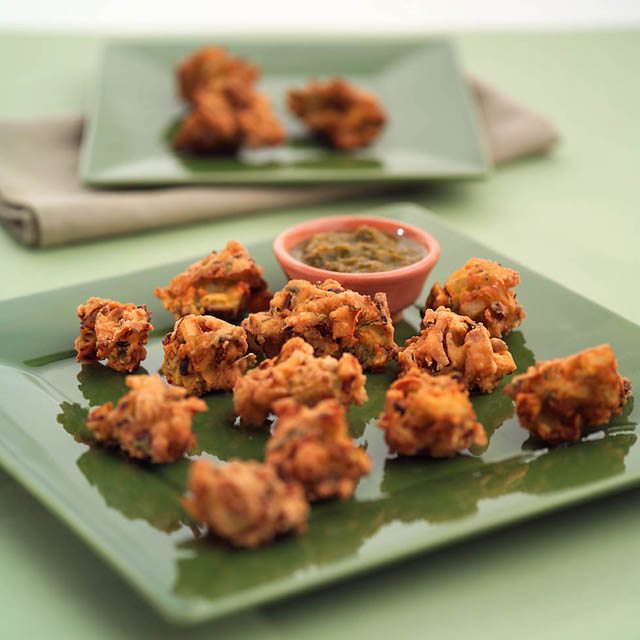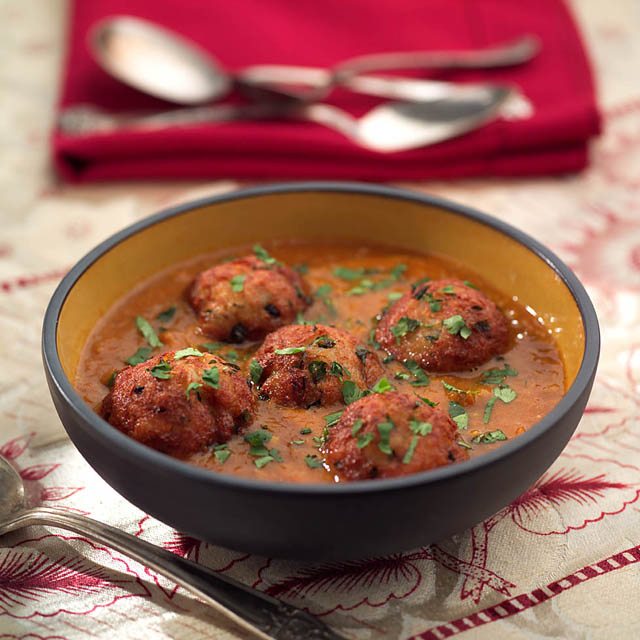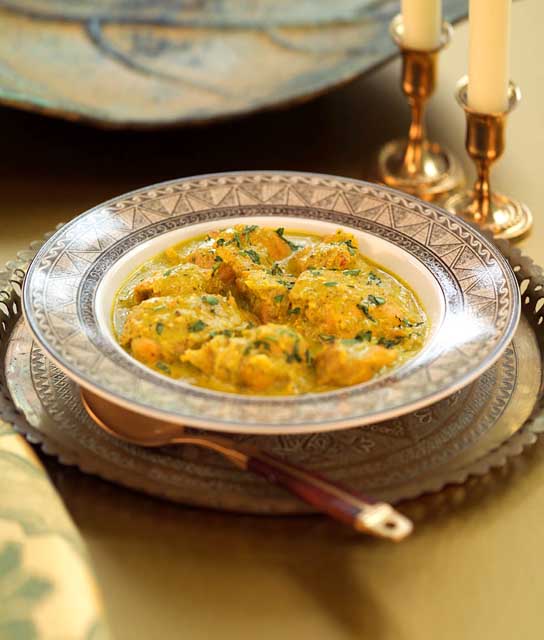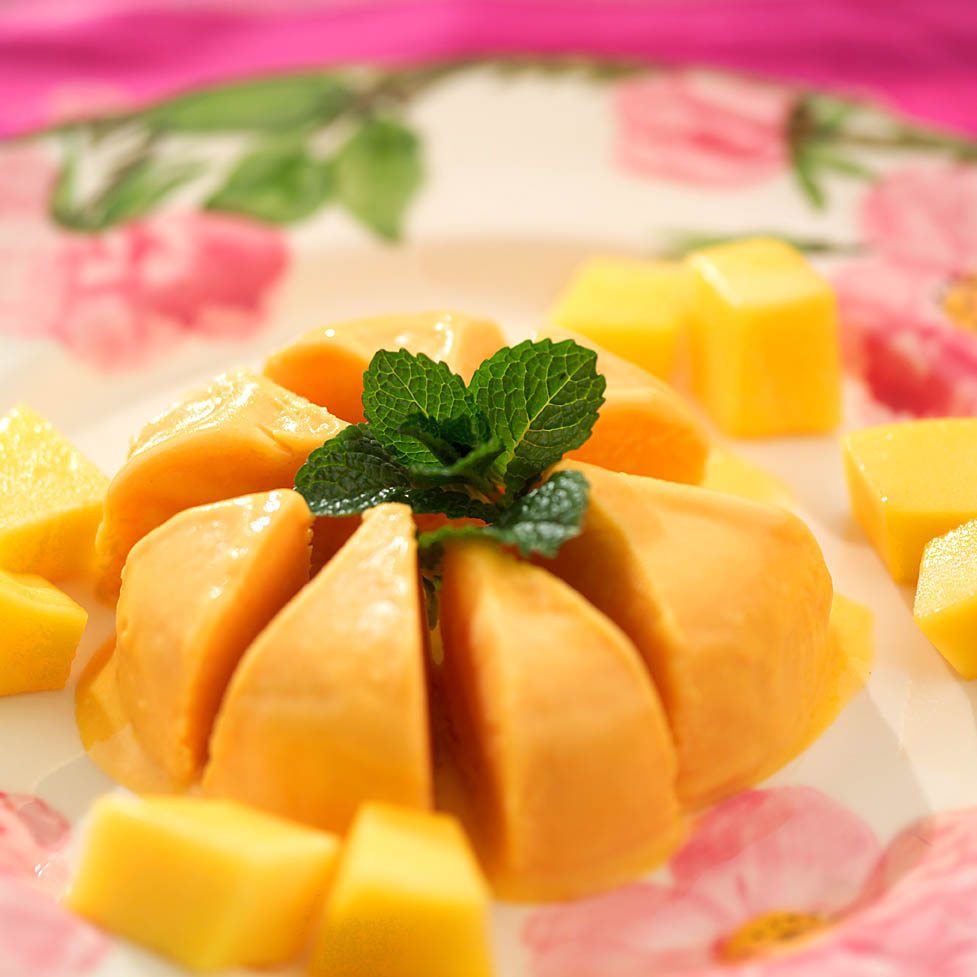8745 people reached on Lassi with Lavina FB page – 582 engagements
[dropcap]I[/dropcap]n ‘Ajanta – Regional Feasts of India’ cookbook author and restaurateur Lachu Moorjani explores the diverse foods of India, with regional feasts from different states. Here he shares some recipes from different regions of India. Come hungry!
Nearly a decade later – his restaurant under new ownership is just as popular as ever. Moorjani, himself retired, is enjoying the fruits of retirement via travel – and home cooks and Ajanta goers continue to enjoy his delicious recipes. Yesterday over 800 visitors to Lassi with Lavina made a beeline straight to this article – I don’t know what is pulling them in – has to be the great Sindhi sanha pakoras! Try out the recipe!

Sindhi Sanha Pakoras
(Chickpea-Flour Fritters)
Pakoras, or chickpeas fritters, are very popular all over India and most regions have their own version. Usually Pakoras are made by dipping slices of potatoes or other vegetables in a batter made with chickpea flour (called besan in Hindi) and then deep-frying them. Chickpea-flour batter is often flavored with spices, which may include turmeric, chile flakes, cumin powder, ajwain, etc. At times, some rice flour or baking powder is added to the batter to make the pakoras crispier.
Sindhi Sanha Pakoras are different from most pakoras made in the rest of India. Onions and potatoes,are finely diced and mixed with many other ingredients, such as ginger, chile peppers, cilantro and pomegranate seeds. The result, in my very biased opinion, is pakoras that taste better than any others in the rest of India.
Ingredients
Serves 6
1 cup chickpea flour
1/2 cup finely chopped onion
1/2 cup finely diced potatoes (1/8- to 1/4-inch dice)
1 tablespoon dry pomegranate seeds, coarsely pounded
1 tablespoon coriander seeds, coarsely pounded
1 teaspoon salt
1-inch piece ginger, finely diced
1/2 teaspoon baking powder
1 teaspoon chile flakes
1/4 cup loosely packed chopped cilantro
Oil for deep-frying
1. Mix all the ingredients except oil and add just enough water to make a thick paste.
2. Heat the oil in a frying pan. Using a large spoon, drop several large dollops (2 to 3 inches in diameter) of the paste, into the hot oil and deep-fry to a golden brown at medium to high heat. Do not fry too many Pakoras at one time. The temperature of the oil will fall down and the pakoras (potato cakes fall apart, Pakoras don’t) will soak up too much oil, becoming heavy. Remove and place in a tray or platter lined with paper towels. Repeat until the entire mixture is finished.
3. Break up the fritters into about 1-inch pieces, and fry these pieces one more time at high heat to a crispy, dark golden-brown color. Remove and place on another platter lined with paper towels. Serve with Mint Cilantro Chutney.
Mint Cilantro Chutney
Ingredients
1 large tomato, coarsely chopped
1/2 medium onion, coarsely chopped
2 to 3 tablespoons tamarind concentrate 2 cups loosely packed cilantro (about 1 bunch), washed and thick stems removed
1/2 cup mint leaves (about 1/2 bunch), washed
1 green serrano chile pepper, about 3 inches long, chopped (optional)
1/2 teaspoon salt
1. Make the tamarind concentrate by soaking a large lemon-size ball of tamarind in enough water to cover it in a small bowl for 1 hour. Mash with fingers to dissolve. Strain using a sieve. The final concentrate should be the consistency of thick buttermilk.
2. Puree all ingredients together in a blender. The blender will work better if moist ingredients (tomato, onion and tamarind concentrate) are pureed first. Taste and adjust for salt and tamarind.

Paneer Kofta
(Paneer cheese balls in a creamy curry sauce )
Kofta is an Indian word for balls made with vegetables or meat, usually served in a curry sauce. Indians are very fond of kofta dishes. Many versions, both vegetarian and non-vegetarian, are made all over India. Koftas made with paneer cheese, also known as Malai Kofta, are considered very desirable because paneer cheese is a good source of protein. This is an elaborate preparation, but the dish is worth all the trouble.
Ingredients
Serves 6
Curry sauce:
3 tablespoons oil, for curry sauce
6 cloves garlic, chopped fine
1 medium (1/2-pound) onion, cut into quarters and sliced very thin
2 teaspoons paprika
Up to 2 teaspoons hot chile pepper powder (to taste, or may be omitted for a very mild dish)
3 teaspoons cumin powder
1 1/2 teaspoons turmeric powder
2 teaspoons salt
4 medium (1 1/2 pounds) tomatoes, chopped fine
3/4 cup heavy cream
1 1/2 teaspoons Garam Masala
Paneer cheese for koftas:
1/2 gallon whole milk
1/3 cup (5 tablesPoons) white vinegar
Koftas:
3 medium (1 1/3 pounds) () red or yellow potatoes
(Paneer cheese is made fresh from milk )
3 slices white bread, processed into breadcrumbs
1 teaspoon salt
2 teaspoons powdered dry pomegranate seeds
1 1/2 teaspoons ajwain seeds
1 teaspoon chile flakes
1 tablespoon finely chopped chile pepper (optional)
1/4 cup loosely packed cilantro
Oil for deep-frying
For Curry Sauce:
1. Heat oil in a 6- to 8-quart nonstick pot. When hot, add garlic and sauté for about 10 seconds. Oil should be hot enough so that the garlic sizzles when added. Add onion and sauté at medium to high heat, stirring every minute or so, until translucent, about 8 to 10 minutes.
2. Add all the spices except salt and Garam Masala and sauté for about 3 to 5 minutes. Then add the chopped tomatoes and stir and sauté for about 5 minutes,. Transfer to a food processor and coarsely grind the mixture by pulsing 5 to 6 times (This step is optional. When done, it results in a smooth, homogeneous sauce.) Transfer mixture back to the pot and place on low to medium heat; add 1 cup water, cover and slowly simmer for about 30 to 40 minutes, or until a sheen of oil is seen on the top. Check and stir every 5 minutes to make sure the sauce does not stick to the bottom of the pan. If that happens, reduce the heat slightly. The finished sauce should have a consistency of heavy cream. If the sauce is too thick, add some water. If it is too thin, remove the lid and boil off some of the liquid. Remove from heat and reserve.
3. Swirl in the cream and mix. Sprinkle Garam Masala on top.
For Paneer cheese for koftas:
1. In a saucepan, bring milk to a boil. Stir in 1/3 cup of white vinegar, then turn off the heat. The milk will curdle. Let it cool.
2. After about 20 minutes, strain the curdled milk through a piece of muslin. Squeeze off any excess moisture by twisting and wringing the cloth around the curds. Place the curds left in the cloth under a heavy pot or some other heavy object filled with water to squeeze out more moisture. Remove from under the weight after 40 minutes and crumble the paneer cheese.
To prepare Koftas:
1. Boil potatoes; when cooked, cool, peel and mash. Add crumbled paneer cheese, breadcrumbs, salt, spices and cilantro.
2. Divide potato mixture into twenty-four equal parts, and roll each part into a round ball about 1-1/2 inch in diameter in your palms. Deep fry the balls 3 to 5 at a time. Be sure that the oil is very hot, otherwise the kofta balls will fall apart. Do not fry too many balls at a time, or the oil will become cold and the balls will soak up too much oil and become heavy. Deep-frying is best done just before eating.
To serve:
Rimmed soup plates are best for serving Paneer Koftas. Just before serving, heat the Curry Sauce. Ladle some onto each plate and place four kofta balls in the center.
Garam masala: Garam masala, a blend of a few aromatic spices, used all over India. The exact recipe varies from cook to cook. Every cook likes to prepare his or her own blend of spices and call it garam masala. Some of the ingredients very commonly used for garam masala are cardamoms, cloves and cinnamon. In addition, peppercorns, cumin, coriander seeds, nutmeg, mace may also be added. The spices used for the blend are roasted whole and then ground up. The garam masala is best prepared fresh and used quickly. Stored garam masala loses its potent aromatic quality quickly. I like to use my own version of garam masala and the recipe for my version is shown below:
Roast in a skillet a mixture of
1 tablespoon whole cardamom
1 tablespoon cloves
One 2 to 3 inch stick cinnamon, broken into 3 to 4 pieces
1 tablespoon peppercorn
A few blades of mace
Roasting should be done until the spices become slightly brown and emit a strong aroma. Transfer to a spice grinder and grind fine. Add a few shavings of nutmeg. Store in a tightly covered jar and use as soon as possible.

Malabar Chicken Curry
this dish originates from the Malabar Coast, which spans the west coast states of Karnataka and Kerala in south India. This is a light curry with robust flavors. It is eaten hot in south India.
Ingredients
Serves 6
3 tablespoons oil
2 teaspoons mustard seeds
1-inch piece ginger, chopped
3 to 4 dried red chiles, broken in pieces
3 medium onions, quartered and thinly sliced
2 pounds boneless, skinless chicken (dark meat recommended), cut in 1 to 2 inch pieces (see Tip below here.)
2 teaspoons coriander powder
1 teaspoon turmeric powder
2 teaspoons paprika
1/2 to 2 teaspoons hot chile pepper powder, to taste
2 teaspoons fennel powder
1 1/2 teaspoons black peppercorns
1 1/2 teaspoons salt
1 cup coconut milk
2 medium potatoes, peeled and cut into 3/4-inch-cubes
8 to 10 curry leaves
1. In a 6- to 8-quart saucepot, heat the oil. When hot, add mustard seeds. Fry for about 10 to 15 seconds. When mustard seeds pop, add ginger and broken red chiles and fry for another 15 seconds.
2. Add onions and sauté over medium to high heat until slightly brown, about 10 to 12 minutes. Raise the heat to high and wait 1 to 2 minutes, or until the pan gets very hot. Add chicken and stir-fry until almost all the moisture has dried up and the chicken is nicely browned.
3. Reduce heat to medium; add all the spices and salt. Stir for 3 to 4 minutes and then add coconut milk (shake can before opening). Bring the mixture to a boil; add 1/4 cup water if there is not enough liquid. Reduce heat, add potatoes, cover and simmer slowly for about 20 to 25 minutes, or until chicken and potatoes are tender. Add curry leaves during the last 5 minutes of cooking.
Tip on choosing light or dark meat in chicken recipes: I recommend using dark meat in chicken recipes because use of dark meat results in a better-tasting sauce. But if white meat is your preference, by all means, use it. If choosing dark meat, keep in mind that seven whole legs of chicken weigh about 4 pounds and yield about 2 pounds after skinning and deboning.

Aam di Kulfi
(A frozen dessert made with Mango, Milk and Cream)
Kulfi, prepared in many variations, is as popular among children and adults in India as ice cream is in the United States. Having grown up in India, I have fond memories of running out and buying kulfi popsicles whenever the kulfi cart wandered into the neighborhood.
Ingredients
(Serves 6)
1/2 gallon half-and-half
Seeds from 6 to 8 cardamom pods (about 1 to 1-1/2 teaspoons)
1/3 to 1/2 cup sugar
1-1/2 cups mango puree
1. In a thick-bottomed 6- to 8-quart saucepan, bring half-and-half to a boil on high or medium-high heat. Stir once every minute or so with a wire whisk, dislodging any milk solids that might adhere to the bottom of the pot, to prevent the milk from getting a burnt flavor. Add cardamom seeds during this time.
2. Once the milk starts to boil, reduce heat to medium and continue cooking for 1 to 1-1/2 hours, stirring every 3 minutes or so. Let thicken until it is reduced to about a third of its original volume. Check the volume by dipping a wooden spoon in the milk and measuring the height before and after thickening. At this time, the reduced liquid should have a consistency of thick buttermilk.
3. Add 1/3 cup sugar and stir to dissolve. Let cool. Add pureed mangoes. Taste and adjust for sweetness by adding more sugar if necessary. Pour the thickened milk-and-mango mixture into six ramekins. Freeze the kulfis.
4. To soften the kulfis for serving, transfer them to the refrigerator about 1/2 hour beforehand. Serve in the ramekins or transfer to a plate by holding the ramekin on its side in running water and then turning it upside down on a serving plate. Cut into 6 slivers.
.

9 Comments
Surbhi Sahni via Facebook
Awesome, Lavina!
Navina Chhabria via Facebook
My favorite!
Rajni Memon via Facebook
Looks amazing!
Alka, I connect with what you’re saying – growing up, sana pakora was THE treat at home. Wish there was a way of doing baked sana pakoras but I guess it’s the oil which makes them so delicious!
Swati, happy cooking and heavenly eating!
Thank you Dimpy – time to try the recipes.
Yum pics and rocking recipes…Well a plate of hot sanna pakoras with mint coriander chutney on a rainy day used to be a blissful thing for us..darn the deep-fry taboo…I want that plate now…I mean it!!
Yummmm!! Cant wait to get home and start cooking now!
I liked all the food items.